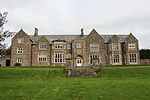Folly Farm, Somerset

Folly Farm is a traditionally managed working farm and nature reserve run by the Avon Wildlife Trust. It is located between Stowey, Clutton and Stanton Wick in the civil parish of Stowey in the English county of Somerset. The farm house is 18th century and the surrounding land includes neutral grassland, wildflower meadows and woodlands with splendid views. Much of Folly Farm is designated as a biological Site of Special Scientific Interest. Some of the land has never been ploughed. The SSSI comprises two adjacent areas, the meadows (19.36 hectares) and Dowlings Wood (9 hectares). It is also a Local Nature Reserve.It can be found near Bishop Sutton in the Chew Valley, just off the A368. The site is situated on a curved ridge of land on neutral soils derived from the underlying Keuper Marl. The soil is of the Icknield Association with dark brown, moist but moderately well-drained clay. The 250 acres (100 ha) nature reserve includes the Folly Oak which is over 400 years old.
Excerpt from the Wikipedia article Folly Farm, Somerset (License: CC BY-SA 3.0, Authors, Images).Folly Farm, Somerset
Featherbed Lane, Bristol Stowey-Sutton
Geographical coordinates (GPS) Address Website External links Nearby Places Show on map
Geographical coordinates (GPS)
| Latitude | Longitude |
|---|---|
| N 51.34132 ° | E -2.56559 ° |
Address
Folly Farm
Featherbed Lane
BS39 4DW Bristol, Stowey-Sutton
England, United Kingdom
Open on Google Maps









